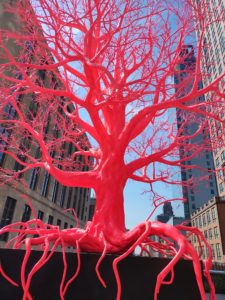We’ve all heard the stories of famous writers who suffered through many rejections before getting published, like Stephen King and J.K. Rowling. Kate DiCamillo got 473 rejections before publishing her Newberry Award novel, Because of Winn Dixie. And one of the most telling rejection stories is about the man who retyped a National Book Award-winning Jerzy Kosinski novel and sent it under an unknown name to a bunch of major publishers, all of whom rejected it.
And since many agents and literary journals report their acceptance rate as around 1-5%, none of us should offer our work to the wider world unless we expect to get rejections. A lot of them. A common recommendation is to aim for 100 rejections each year.
If you send out that much work, the chances you may get a few acceptances are much higher. My batting average is around 10% acceptances for poems, less for other projects, but that’s because I submit to a range of publications. If I only submitted to prestigious journals, my acceptance rate would be much lower, though I do review journals and only submit to those I like. I didn’t track how many longer fiction queries and pitches were rejected before I had a novel accepted for publication–the fourth one I wrote. But I can say with confidence that it was well more than 100. I remember gawking at the acceptance letter when it came, thinking this can’t be real, and then hoping I wouldn’t die before the publication date, which was listed as two full years away.
Usually, rejection letters are neutral. Thank you for submitting, but this work doesn’t fit our needs at this time. Good luck placing it elsewhere. Sometimes, an editor will tell you that your work came close and invite you to submit again. This is considered an encouraging rejection and should not be lamented, but celebrated.
I make a point not to let a rejection bother me for more than five minutes. Nonetheless, I was a bit ticked off last year when I got the following letter in response to an anthology looking for published and unpublished “cool short stories.”
Thanks for submitting ‘Will This Be the Last Time.’ We appreciated the premise of a couple who tries to escape the U.S. to Canada, but we’re not sure this story fully committed that premise; in fact, as this story’s plot points unfolded, we weren’t quite sure what this story’s premise was. (To us, it felt a bit more like autobiographical fiction than it did like a well-plotted, tense, suspenseful short story–which is what we’ve promised our readers our selections will be.)
I’m sure these editors are patting themselves on the back for taking the time to offer feedback. And feedback can be useful in knowing how our work is hitting people—or isn’t. But if the goal for giving feedback is to help the writer improve, what could I possibly do with this comment? If a reader thinks the story’s premise is faulty, which is totally fair game, then they should take the time to say where they think it veered off course and what scenes or plot points made the premise confusing to them. Then as a writer, I can ponder those scenes with that feedback in mind and think about possible changes. And if that’s too much work for a submission editor, it’s fine to say the story doesn’t meet their needs.
And the last sentence! I take issue with the implication that autobiographical fiction is inherently bad, even though the only autobiographical elements in this story related to the fear I felt during the Trump years rather than any actual truth in my life.
And instead of saying something reader-centered at the end, like “Good luck placing this elsewhere,” this anthology ended its letter by asking me to follow them on Twitter because they need more followers.
A truly reader-centered rejection letter will often add the extra-nice element, saying, I know these decisions are subjective. Which they are. This story had already been accepted and published–amazingly by the first journal I sent it to, and it’s included in my upcoming collection, Immigrants.
What ticks me off the most is that this is the kind of letter that will send many rejection-sensitive people burrowing back into their dens, when they have so much beautiful writing that the world would be better for reading. So that’s why I’m highlighting this rejection, which, I admit, did annoy me for more than my allotted five minutes, and still rankles months later. Caveat scriptor—writer beware. If you get a letter like this, ignore it and keep writing—and submitting. In fact, add five extra rejections to your goal for the year. That’s I’m going to do.
To subscribe to this blog, sign up at ddinafriedman.substack.com




